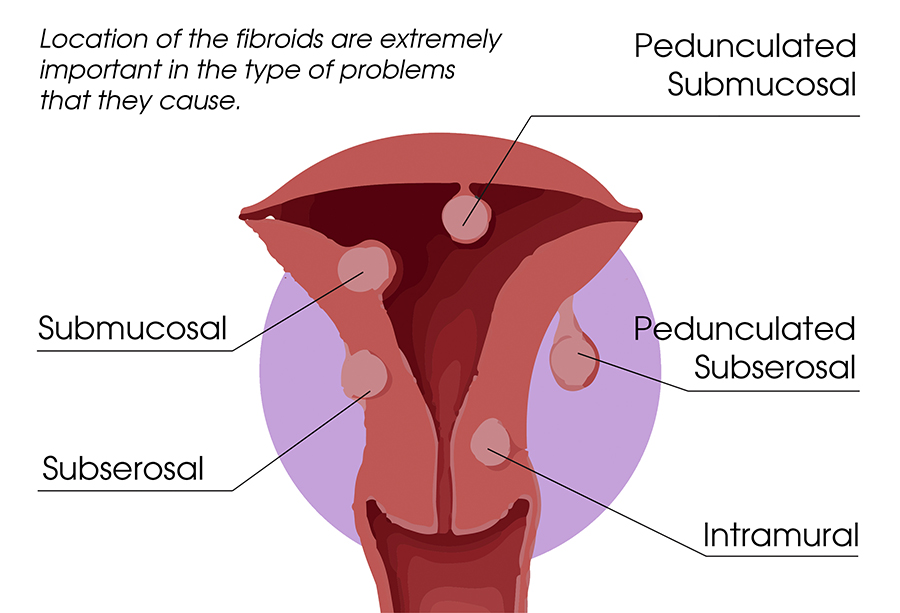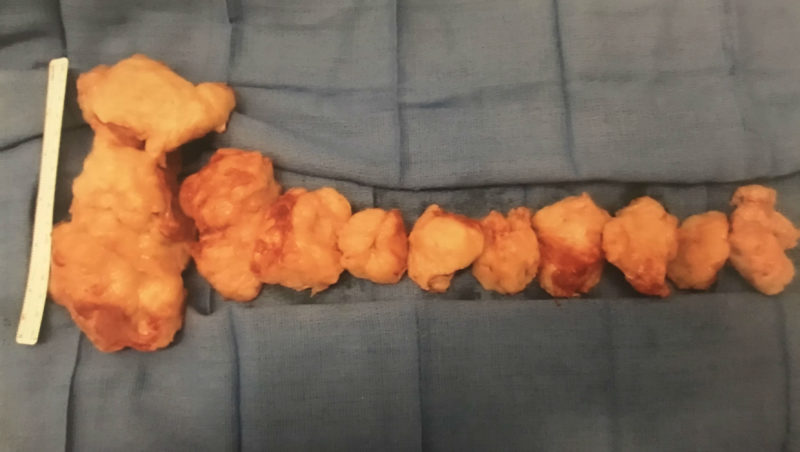Fibroids Specialist in Los Angeles
Fibroids are the most common non-cancerous tumors arising from the uterus. Also known as myomas, and fibromyomas. Up to 70% of the general population but more common in African American women (up to 80%), two to five times more common. The average uterus has six to eight fibroids and fibroids cause symptoms in 20-50% of women. Fibroids are extremely common, non-cancerous growths or tumors and they rise from the muscular walls of the uterus. They are composed of muscle tissue and can range in size from less than an inch in length to up to eight inches or more, the size of a melon. Fibroids start from a small microscopic origin at the time of puberty and gradually increase in size. They are fed by the hormones produced by the ovaries and nourished by the blood flow that irrigates the uterus and the ovaries. Fibroids are generally benign with less than 1% chance of malignancy. It is thought that three out of four women in Los Angeles and across the country have fibroids and one out of three women has fibroids that require treatment.
What are the types of fibroids?
If you consider the uterus as a room then fibroids can be classified by their location in this room (location of the fibroids are extremely important in the type of problems that they cause):

- Subserosal, like a chimney
- Intramural, in the wall
- Submucosal, like a wall fixture
- Intacavitary, like a chandlier
More that 200,000 hysterectomies are performed each year to relieve symptoms of fibroids. The majority of these women can avoid a hysterectomy in our centers. We proudly have the lowest hysterectomy rates for treatment of fibroid tumors. Every day we offer women that have been told they need hysterectomy minimally invasive options to spare their organs.
Symptoms of Fibroids
Fibroids can cause pain and heavy bleeding during menstruation, pain with intercourse, infertility, abdominal distention, and urinary frequency. Women with fibroids can also have complicated pregnancies. Fibroids increase the risk of preterm labor, miscarriage, and may compromise fetal growth. Also, they may degenerate during pregnancy and cause significant pain. learn more>>
Diagnosis of Fibroids
Diagnosing and identifying the location of each fibroid is easily done in our offices. We use simple non-invasive or minimally invasive techniques such as ultrasonography, hysterosonography or office hysteroscopy to evaluate the size and location of these fibroid tumors. Ultrasonography and hysterosonography utilize sound waves (non x-ray) to obtain a clear image of the uterus. We use 3-D ultrasound to determine the location and volume of each fibroid tumor. Office hysteroscopy allows direct visualization of the endometrial cavity and sampling of suspicious lesions. Both the physician and patient can visualize the fibroid tumor on the monitor as it is being performed. Diagnosis can be made in the office very accurately using the latest in 3D and 4D ultrasonography. For difficult to visualize fibroids, combination of ultrasonography and injectionand distention of the uterine cavity with fluid, Hysterosonography, gives a clearer and complete picture of the uterus and can be performed in the office. As a result of recent advances in fibroid research, treatment options are many and very effective. Hormonal therapy can be used to manage the bleeding and pain resulting from the fibroids. Fibroids however continue to grow despite the symptom management until menopause when the body no longer produces hormones that stimulate the fibroid growth. learn more>>
Fibroids Treatment Options in Los Angeles

Medication can offer relief from the symptoms of fibroids and even slow or stop their growth. But, once you stop taking the medicine, the fibroids often grow back. Lupron, progestational agents, and birth control pills help alleviate some of the symptoms of the fibroids. Fibroids symptoms usually return when medical treatment stops. Minimally invasive surgical options are available that can eliminate the fibroids. Laparoscopic and hysteroscopic surgery, robotic assisted myomectomy and vaginal surgery are all effective options that can be used to remove these troublesome tumors. Uterine artery embolization can be used to cutoff the blood flow to the fibroids and allow the body to disintegrate and reduce the fibroid to an inactive fibrous mass. learn more>>
Fibroids & Pregnancy
Our team can evaluate and monitor your fibroids and estimate the potential impact on your pregnancy. learn more>>
Dr. Tahery, is an expert in fibroid treatment and is a member of Cedars Sinai Center of Excellence in minimally invasive surgery used for treatment of uterine fibroids. Additionally, our practice is one of the few fibroid treatment groups with a dedicated team and surgical facility for treatment of fibroids.
if you suspect that you have fibroids or have been told that you have them and would like to explore your options please call us for a consultation. We look forward to helping you with your problem.
What are uterine fibroids?
Fibroid tumors are common, benign growths of the uterus. It is estimated that fibroids can be found in 70-80% of women with increased frequency in African American women. Studies have shown a genetic link in families with fibroids. Fibroids begin from a single cell that is formed during puberty. Although they are considered a tumor, they are benign and only very rarely become cancerous. They are composed of tissue that is similar to the uterus itself, and usually grow along its walls, but they can grow along the outside or project into the uterus, as well. They can appear singly, or in clusters, and can range in size from as tiny as a pea to melon-sized or larger.
Fibroids are made up of muscle and fibrous tissue and start as a microscopic cell inside the uterus and grow with hormonal stimulation after puberty. It is not clear why some fibroids grow rapidly and others hibernate, however the bothersome symptoms are usually due to their location within the uterus.
They can be in the uterine muscle or intramural; attached to the inside lining of the uterus or submucosal; attached to the outside wall of the uterus or subserosal; in the uterine cavity or intramural.
How common are uterine fibroids?
Estimates vary because not every woman knows she has them or seeks medical treatment, but approximately one-third of women are believed to have them. They are more common among women between the ages of 35 and 50 and are more common among African-American women than the population as a whole.
Are uterine fibroids cancerous?
Uterine fibroids are almost always benign. Less than 1% becomes cancerous, and some studies suggest the number is as small as one-tenth of one percent.
What causes uterine fibroids?
The answer isn’t clear, but heredity may play a part. A single muscle cell in the uterus changes into a fibroid tumor during puberty, and the increased presence of estrogen may add to their formation and growth.
How long have I had them?
The cells that develop into fibroids are born with us. During puberty, when your ovaries begin releasing estrogen, these cells are stimulated and can begin to grow.
What is the difference between fibroid and myoma?
There is no difference. Those are two names for the same thing.
Do I need surgery to treat them?
Not necessarily. Not every woman who has fibroids needs surgery, and unless the fibroid is producing symptoms that interfere with your life, you and your gynecologist at FTG: LA may just adopt a “watch and wait” program to monitor them. Every woman is different, and we can evaluate your case in our office and together we can decide on the right treatment for you.
If I have surgery, how long before I can go back to work?
Recovery time depends on the type of surgery that was performed. If your fibroids were removed through a hysteroscopic myomectomy, you can usually return to work the following day, but if a hysterectomy is performed, it may be six to eight weeks before you can. Those patients who have their fibroids removed through UAE, a minimally invasive procedure, often return to work the following week.
How do I pay for treatment?
Most insurance plans provide coverage, and our staff of experts can help you get approval for your treatment. We also offer reasonable cash prices, and the charges at our FTG: LA facility can be significantly lower than hospital prices.